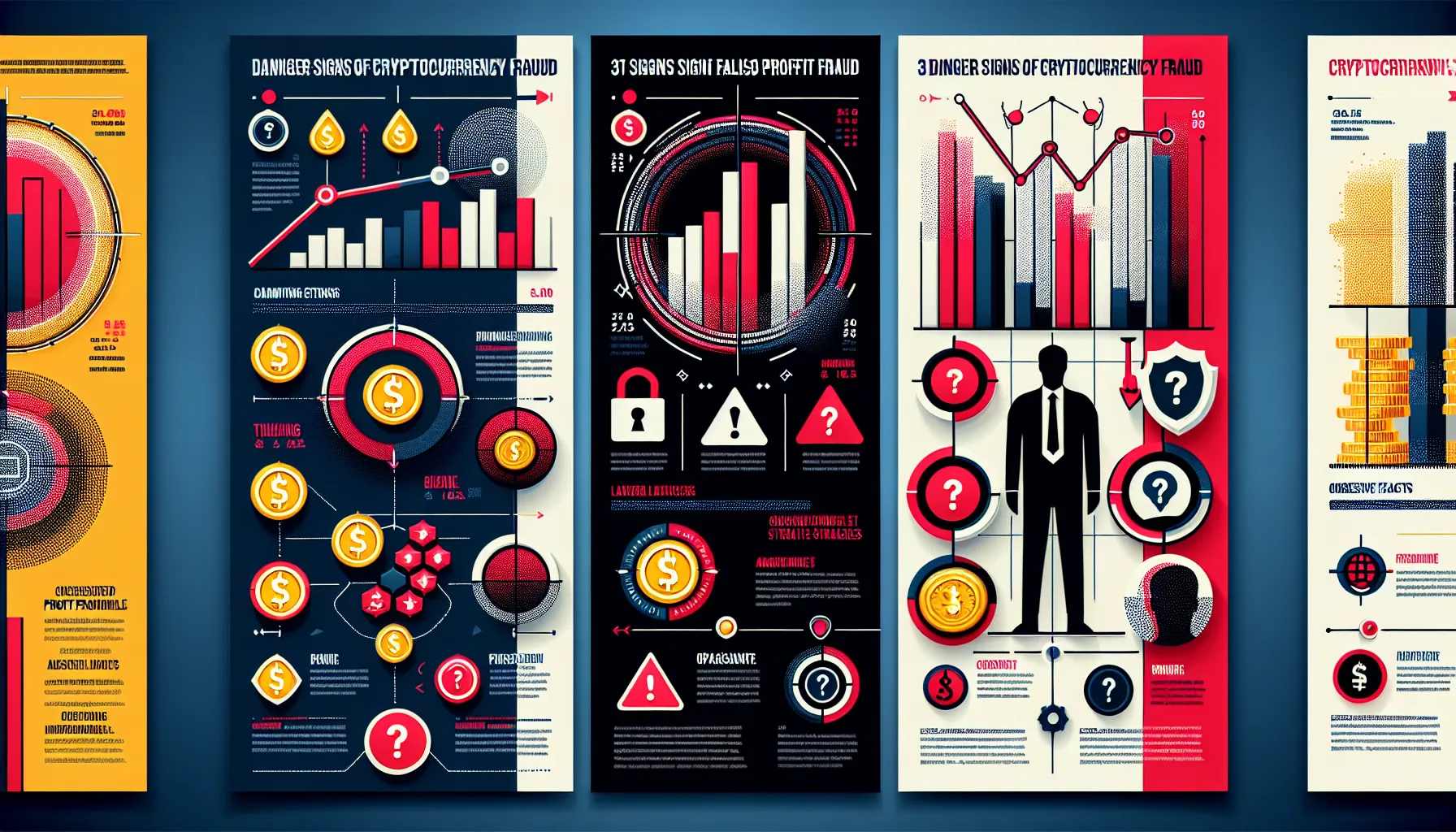The promise of quick wealth and revolutionary technology has drawn millions into cryptocurrency, but alongside genuine innovation lurks a shadowy underworld of fraud. Every day, investors, from seasoned traders to curious newcomers, fall victim to scams designed to exploit crypto’s relative anonymity and the public’s limited understanding of blockchain technology. The losses are staggering, often irreversible, and deeply personal.
Yet these scams aren’t unstoppable. Most fraudulent schemes share tell-tale warning signs that, once recognised, can protect individuals from financial ruin. Whether it’s a flashy investment platform promising guaranteed returns, a WhatsApp message from a supposed crypto adviser, or a new token project that vanishes overnight, scammers rely on similar tactics: urgency, opacity, and appeals to greed or fear. By learning to identify these red flags and adopting a systematic approach to verification, investors can navigate the crypto landscape with confidence and scepticism in equal measure.
This guide walks through the most common indicators of crypto fraud, explains the types of scams currently proliferating, and provides actionable steps to verify opportunities and protect funds. If something feels off, it probably is, and knowing what to look for could save thousands.
Key Takeaways
- Learning to spot crypto scams before losing money relies on recognising red flags like guaranteed returns, pressure tactics, and lack of transparency.
- Common crypto scams include fake investment platforms, Ponzi schemes, phishing attacks, impersonation schemes, and rug pulls in DeFi projects.
- Always research the project team thoroughly, verify regulatory compliance with the FCA, and check for third-party security audits before investing.
- Never share private keys, seed phrases, or authentication codes with anyone, as legitimate platforms will never request this information.
- If you suspect a crypto scam, report it immediately to Action Fraud, cease all contact with the scammer, and monitor your accounts for further suspicious activity.
- Adopting a sceptical mindset towards unsolicited investment offers and refusing to rush decisions are essential habits for protecting yourself from crypto fraud.
Understanding the Landscape of Crypto Fraud

Cryptocurrency’s explosive growth has created fertile ground for fraud. The technology’s complexity, combined with the sector’s often lax regulation and the irreversible nature of blockchain transactions, makes it an attractive playground for criminals. Fraud in the crypto space isn’t a niche problem, it’s widespread, sophisticated, and evolving.
Recent years have witnessed a surge in investment scams, phishing attacks, Ponzi schemes, and entirely fabricated projects. Scammers have adapted quickly, moving from crude email cons to polished websites, fake apps, and even deepfake videos impersonating well-known figures. They exploit the decentralised ethos of crypto to operate across borders, making enforcement difficult and victim recovery rare.
Newcomers are especially vulnerable. With limited technical knowledge and high enthusiasm, they’re prime targets for schemes that promise easy profits or exclusive access. Fraudsters often pose as legitimate businesses, financial advisers, or crypto influencers, leveraging trust and FOMO (fear of missing out) to manipulate behaviour. Some scams are highly organised, involving call centres, fake trading platforms, and fabricated testimonials.
Understanding this landscape is the first step in defence. Crypto fraud isn’t random, it follows patterns. Recognising those patterns, and the environments in which scams thrive, equips investors to ask the right questions and avoid the traps set for the unwary.
Red Flags That Indicate a Potential Crypto Scam

Spotting a scam before parting with money hinges on recognising warning signs that legitimate ventures rarely display. Three red flags, in particular, should trigger immediate caution.
Promises of Guaranteed Returns or Unrealistic Profits
Any investment opportunity claiming guaranteed returns or consistent, high profits with little to no risk is almost certainly fraudulent. Cryptocurrency markets are notoriously volatile, prices swing wildly, projects fail, and even established tokens experience downturns. Legitimate platforms and fund managers acknowledge these risks openly.
Scammers, but, prey on greed and inexperience by offering the impossible: steady monthly returns, “risk-free” strategies, or promises to double investments in short timeframes. These claims are designed to bypass rational scrutiny and trigger emotional decision-making. If an opportunity sounds too good to be true, it invariably is.
Pressure to Act Immediately or Miss Out
Urgency is a scammer’s best friend. Phrases like “limited spots available,” “offer ends tonight,” or “you’ll miss out if you don’t invest now” are deliberate tactics to prevent potential victims from conducting due diligence. Legitimate investment opportunities don’t evaporate overnight, and reputable projects welcome questions and careful consideration.
When someone insists on immediate action, whether through relentless messaging, countdown timers on websites, or threats that the “opportunity” will vanish, it’s a sign they don’t want the target to think critically or seek second opinions. Rushed decisions are bad decisions, especially in an arena as complex as crypto.
Lack of Transparency or Verifiable Information
Genuine crypto projects and platforms operate with transparency. They disclose team members’ identities, provide verifiable business addresses, publish whitepapers with technical details, and comply with relevant regulations. They’re findable on multiple platforms, discussed in independent forums, and often audited by third-party security firms.
Scams, by contrast, are opaque. Team members may be anonymous or use stock photos and fake names. Contact details are vague or non-existent. Whitepapers, if present, are plagiarised or filled with jargon but lacking substance. Claims about partnerships, endorsements, or regulatory approval can’t be independently verified. When basic information is hidden or fabricated, the project is hiding something, and that something is usually fraud.
Common Types of Cryptocurrency Scams to Watch For
Crypto fraud takes many forms, but certain scam types have become especially prevalent. Recognising the structure and mechanics of these schemes helps investors avoid them.
Fake Investment Platforms and Ponzi Schemes
Fraudsters frequently create slick, professional-looking websites that mimic legitimate crypto exchanges or investment platforms. These sites may allow users to deposit funds and initially display “profits” on their dashboards, but withdrawals are blocked, delayed indefinitely, or require additional fees that are never honoured.
Ponzi schemes operate differently but are equally devastating. They promise high returns and initially pay out using funds from new investors rather than any actual profit-generating activity. As long as recruitment continues, early participants may receive returns, lending the scheme false credibility. Eventually, the flow of new money slows, and the scheme collapses, leaving the majority of investors with total losses. The operators typically vanish, taking remaining funds with them.
Phishing Attacks and Impersonation Scams
Phishing remains one of the most effective methods for stealing crypto. Scammers send emails, text messages, or social media messages that appear to come from legitimate crypto exchanges, wallet providers, or even government agencies. These messages often contain urgent warnings, account suspensions, security breaches, mandatory verifications, and include links to fake websites designed to capture login credentials, two-factor authentication codes, or private keys.
Impersonation scams are a related threat. Fraudsters pose as celebrities, influencers, customer support representatives, or project founders on social media. They might offer giveaways (send a small amount, get double back), request help with a “problem,” or offer exclusive investment opportunities. Once trust is established, they manipulate victims into sending funds or revealing sensitive information.
Rug Pulls and Fraudulent Token Projects
Rug pulls are particularly insidious in the decentralised finance (DeFi) space. Developers create a new token or liquidity pool, hype it heavily on social media and forums, and attract investment. Once a substantial amount of capital is locked in, the developers withdraw all funds from the liquidity pool and disappear, leaving the token worthless and investors unable to sell.
These scams exploit the ease with which anyone can launch a token on platforms like Ethereum or Binance Smart Chain. Many rug pulls involve anonymous teams, no audits, and aggressive marketing that preys on FOMO. Some are sophisticated, involving fake partnerships, cloned websites, and fabricated community engagement to appear legitimate until the moment they aren’t.
How to Verify the Legitimacy of a Crypto Opportunity
Due diligence is the most effective defence against crypto fraud. A methodical approach to verification can expose scams before any funds change hands.
Research the Team and Project Background
Start by investigating the people behind the project. Are team members’ names and photos publicly available? Do they have verifiable LinkedIn profiles, Github repositories, or records of previous work in the crypto or tech industries? Reverse image searches can reveal whether profile pictures are stock images or stolen from elsewhere.
Look for a detailed whitepaper that explains the project’s purpose, technology, tokenomics, and roadmap. Compare it against similar projects, plagiarised or vague whitepapers are red flags. Check whether the project has a registered business entity and physical address. Search for independent reviews, discussions on platforms like Reddit or Bitcointalk, and any coverage by reputable crypto news outlets.
Be wary of projects with entirely anonymous teams unless there’s a strong, verifiable reason (such as privacy-focused technologies with a long track record). Transparency breeds trust: opacity breeds suspicion.
Check Security Measures and Regulatory Compliance
Legitimate crypto platforms prioritise security. They carry out two-factor authentication, cold storage for user funds, regular security audits, and clear procedures for account recovery and dispute resolution. If a platform lacks these basics, it’s either inexperienced or intentionally negligent, both are dangerous.
Regulatory compliance is another critical marker. In the UK, crypto businesses offering certain services must register with the Financial Conduct Authority (FCA). Check the FCA’s register to confirm a platform’s status. Be cautious of entities operating without any regulatory oversight or those making false claims about licences and approvals.
Third-party audits by reputable security firms (such as CertiK, Quantstamp, or Trail of Bits) add credibility, especially for DeFi projects and new tokens. If a project claims to be audited, verify the audit report directly on the auditor’s website, don’t rely solely on links provided by the project.
Finally, test customer support. Legitimate platforms respond promptly and professionally. If contact details are missing, support is unresponsive, or replies seem generic and evasive, consider it a warning.
Protecting Yourself From Crypto Fraud
Prevention is always better than recovery. A few consistent practices can dramatically reduce the risk of falling victim to crypto scams.
First, adopt a sceptical mindset towards unsolicited contact. Whether it’s a direct message on social media, an email from an unknown sender, or a random WhatsApp from someone claiming to offer investment advice, treat it with suspicion. Scammers initiate contact: legitimate opportunities are usually found through your own research.
Never share private keys, seed phrases, passwords, or two-factor authentication codes with anyone. No legitimate platform or support representative will ever ask for these. They are the keys to your funds, and sharing them is equivalent to handing over your bank account.
Double-check all URLs before entering credentials or sending funds. Scammers create lookalike websites with slight misspellings or different domain extensions. Bookmark trusted sites and access them directly rather than through links in emails or messages.
Use reputable exchanges and wallets with established track records and strong security features. Research user reviews and security incidents before committing funds. Enable all available security measures, including two-factor authentication and withdrawal whitelists.
Diversify where you hold assets and avoid keeping large amounts on exchanges for extended periods. Cold wallets (hardware wallets not connected to the internet) offer the highest security for long-term storage.
Finally, if an opportunity requires you to recruit others to profit, it’s almost certainly a pyramid or Ponzi scheme. Walk away.
What to Do If You Suspect You’ve Been Scammed
Discovering you’ve been scammed is distressing, but swift action can sometimes limit damage and aid investigations.
Immediately stop all further payments or communications with the suspected scammer. Do not send additional funds, even if they claim it’s necessary to unlock your account or recover previous losses, this is a common follow-up scam.
Report the incident to Action Fraud, the UK’s national reporting centre for fraud and cybercrime. Provide as much detail as possible: transaction IDs, wallet addresses, screenshots, emails, and any other evidence. Whilst recovery of crypto funds is difficult, reports help authorities track patterns and potentially disrupt criminal networks.
If the scam involved a UK-based platform or bank transfer, contact your bank immediately. In some cases, banks can halt or reverse payments. For credit card transactions, initiate a chargeback if applicable.
Monitor your accounts closely for further suspicious activity. Change passwords and enable additional security on any accounts that may have been compromised. Consider freezing credit reports if personal information was shared.
Seek advice from specialised recovery services if significant sums are involved, but be cautious, secondary scams target victims by promising recovery for an upfront fee. Verify the legitimacy of any recovery firm thoroughly.
Finally, share your experience. Posting anonymised warnings on forums, social media, or scam databases can prevent others from falling into the same trap. Transparency and community vigilance are powerful tools against crypto fraud.
Conclusion
Crypto scams are sophisticated, persistent, and constantly evolving, but they aren’t unbeatable. By learning to recognise red flags, unrealistic profit promises, pressure tactics, and lack of transparency, investors can filter out the vast majority of fraudulent schemes before any money is at risk. Understanding common scam types, from Ponzi schemes to rug pulls, further sharpens that defensive instinct.
Verification is the cornerstone of protection. Researching teams, scrutinising security measures, checking regulatory compliance, and seeking independent reviews transform vague opportunities into clear judgements. When something doesn’t stand up to scrutiny, it’s almost always better to walk away.
Protective habits, scepticism towards unsolicited contact, safeguarding private keys, using reputable platforms, and refusing to rush, build resilience against fraud. And if the worst happens, knowing how to respond quickly can limit harm and contribute to broader enforcement efforts.
The crypto space offers genuine innovation and opportunity, but it demands vigilance. Legitimate projects and platforms welcome questions, provide transparency, and never pressure investors into hasty decisions. If an opportunity can’t withstand careful examination, it isn’t an opportunity worth taking. Trust the process, trust your instincts, and never let enthusiasm override due diligence.
Frequently Asked Questions
What are the most common warning signs of a crypto scam?
Key red flags include promises of guaranteed or unrealistic returns, pressure to invest immediately without time for due diligence, and lack of transparency about team members, business addresses, or verifiable information. Legitimate crypto projects openly acknowledge market risks and welcome scrutiny.
How can I verify if a cryptocurrency platform is legitimate?
Research the team’s background using LinkedIn and reverse image searches, check for FCA registration in the UK, review independent audits by firms like CertiK, and test customer support responsiveness. Legitimate platforms provide verifiable business addresses and detailed whitepapers with clear technical information.
What is a rug pull in cryptocurrency?
A rug pull occurs when developers create a new token, attract investment through aggressive marketing, then suddenly withdraw all funds from the liquidity pool and disappear. This leaves the token worthless and investors unable to sell, often involving anonymous teams with no third-party audits.
Should I trust crypto investment offers I receive via WhatsApp or social media?
No. Treat all unsolicited investment contact with suspicion, whether through WhatsApp, email, or social media. Scammers initiate contact and often impersonate advisers or influencers. Legitimate opportunities are found through your own research, not through random messages promising exclusive access.
Can I recover my money if I’ve been scammed in a crypto transaction?
Recovery is difficult due to blockchain’s irreversible nature, but act immediately. Report to Action Fraud, contact your bank if transfers were involved, and monitor accounts for further activity. Avoid secondary scams promising recovery for upfront fees. Swift reporting helps authorities track criminal networks.
Are all anonymous cryptocurrency projects scams?
Not necessarily, but anonymity significantly increases risk. Whilst some privacy-focused projects with long track records operate anonymously for legitimate reasons, most genuine crypto ventures provide transparent team information, verifiable credentials, and detailed documentation to build investor trust and demonstrate accountability.






